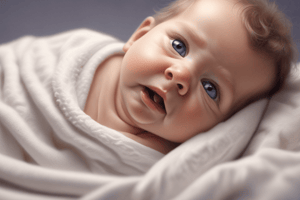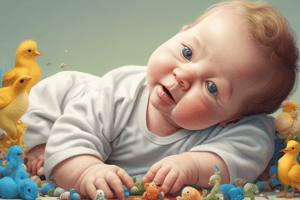Podcast
Questions and Answers
What characteristic is associated with infants born at 24-25 weeks gestational age regarding their skin?
What characteristic is associated with infants born at 24-25 weeks gestational age regarding their skin?
- Skin that is loose and dry.
- Very thin skin with visible veins. (correct)
- Thick skin with minimal visible veins.
- Skin covered with abundant vernix caseosa.
Which of the following statements accurately describes the arm recoil of a full-term infant?
Which of the following statements accurately describes the arm recoil of a full-term infant?
- Arms recoil past 90 degrees. (correct)
- Arms do not show any recoil.
- Arms recoil only to 60 degrees.
- Arms exhibit limited recoil.
What neuromuscular characteristic of a full-term infant is reflected by a popliteal angle of 42 weeks gestation?
What neuromuscular characteristic of a full-term infant is reflected by a popliteal angle of 42 weeks gestation?
- Decreased resistance indicating mature tone. (correct)
- Increased resistance indicating immature tone.
- Normal flexion but with limited recoil.
- Severe hypertonicity of the lower limbs.
What observation regarding the ears would be typical for an infant born at 24-25 weeks gestational age?
What observation regarding the ears would be typical for an infant born at 24-25 weeks gestational age?
Which statement best describes the lanugo of a full-term infant?
Which statement best describes the lanugo of a full-term infant?
What is a primary pathologic cause leading to large for gestational age (LGA) infants?
What is a primary pathologic cause leading to large for gestational age (LGA) infants?
Which of the following is NOT commonly associated with small for gestational age (SGA) infants?
Which of the following is NOT commonly associated with small for gestational age (SGA) infants?
Which characteristic is commonly seen in SGA infants due to their lack of fat stores?
Which characteristic is commonly seen in SGA infants due to their lack of fat stores?
Which of the following conditions can lead to small for gestational age (SGA) due to inadequate fetal nutrition?
Which of the following conditions can lead to small for gestational age (SGA) due to inadequate fetal nutrition?
Which common complication of LGA infants can occur immediately after birth?
Which common complication of LGA infants can occur immediately after birth?
What physical condition related to SGA can increase the risk of impaired gas exchange?
What physical condition related to SGA can increase the risk of impaired gas exchange?
Which assessment method involves measuring the resistance to stretching of extensor muscles in the forearm?
Which assessment method involves measuring the resistance to stretching of extensor muscles in the forearm?
What is the significance of creases on the plantar surface of a neonate's feet?
What is the significance of creases on the plantar surface of a neonate's feet?
Which factor is primarily responsible for increased infant mortality in preterm births in the United States?
Which factor is primarily responsible for increased infant mortality in preterm births in the United States?
At what gestational age do male testes typically descend into the scrotum?
At what gestational age do male testes typically descend into the scrotum?
What observation is associated with increased gestational age regarding the infant's posture?
What observation is associated with increased gestational age regarding the infant's posture?
What is a potential indicator of fetal alcohol syndrome in the mouth examination of an infant?
What is a potential indicator of fetal alcohol syndrome in the mouth examination of an infant?
What Silverman-Anderson Index score indicates no respiratory distress based on chest and abdomen movement?
What Silverman-Anderson Index score indicates no respiratory distress based on chest and abdomen movement?
Which of the following signs in a neonate's ears could suggest Trisomy 13 or Trisomy 18?
Which of the following signs in a neonate's ears could suggest Trisomy 13 or Trisomy 18?
What might a significant lag in head movement when lifted from a supine position suggest about an infant's neck condition?
What might a significant lag in head movement when lifted from a supine position suggest about an infant's neck condition?
At what gestational week does the production of vernix caseosa typically begin?
At what gestational week does the production of vernix caseosa typically begin?
What is indicated by the presence of white patches on a neonate's mucous membranes or tongue?
What is indicated by the presence of white patches on a neonate's mucous membranes or tongue?
Which skin characteristic is often observed in newborns due to apneic conditions or chilling?
Which skin characteristic is often observed in newborns due to apneic conditions or chilling?
Which condition in newborns is characterized by a sudden appearance of erythema over a large skin area?
Which condition in newborns is characterized by a sudden appearance of erythema over a large skin area?
Which assessment technique is used to examine a newborn's initial response to sound?
Which assessment technique is used to examine a newborn's initial response to sound?
What is most indicative of immature sucking ability in infants around 32 weeks of gestation?
What is most indicative of immature sucking ability in infants around 32 weeks of gestation?
If an infant shows asymmetrical movement of the mouth during a sucking assessment, what condition could this indicate?
If an infant shows asymmetrical movement of the mouth during a sucking assessment, what condition could this indicate?
What is a characteristic of normal neonatal eyes?
What is a characteristic of normal neonatal eyes?
What is an abnormal finding in the examination of a neonate's mouth that could signify a disorder?
What is an abnormal finding in the examination of a neonate's mouth that could signify a disorder?
What could indicate a congenital anomaly related to the male genitalia's size?
What could indicate a congenital anomaly related to the male genitalia's size?
Which observation in female genitalia may suggest a gender abnormality?
Which observation in female genitalia may suggest a gender abnormality?
Which characteristic of the testes is considered normal during examination?
Which characteristic of the testes is considered normal during examination?
What indicates possible hydrocele when examining a large scrotum?
What indicates possible hydrocele when examining a large scrotum?
Which of the following statements about vaginal discharge in neonates is true?
Which of the following statements about vaginal discharge in neonates is true?
What sensory capability significantly improves in neonates after clearing their nasal passages?
What sensory capability significantly improves in neonates after clearing their nasal passages?
What characteristic of the neonate's vision is accurate?
What characteristic of the neonate's vision is accurate?
Which physical examination finding in male genitalia should prompt further investigation for urination issues?
Which physical examination finding in male genitalia should prompt further investigation for urination issues?
In evaluating the respiratory status of a neonate, which characteristic should be documented?
In evaluating the respiratory status of a neonate, which characteristic should be documented?
What does bruising of the labia majora in a neonate typically indicate?
What does bruising of the labia majora in a neonate typically indicate?
What characteristic differentiates cephalohematoma from caput succedaneum?
What characteristic differentiates cephalohematoma from caput succedaneum?
What is an indicator of potential gastrointestinal anomalies in a neonate?
What is an indicator of potential gastrointestinal anomalies in a neonate?
During the assessment of a neonate's spine, which finding is concerning for spina bifida occulta?
During the assessment of a neonate's spine, which finding is concerning for spina bifida occulta?
What is a normal finding during a genital examination of a male neonate?
What is a normal finding during a genital examination of a male neonate?
What observation during a musculoskeletal assessment might indicate cerebral palsy?
What observation during a musculoskeletal assessment might indicate cerebral palsy?
Which of the following findings during a rectal examination indicates a concern?
Which of the following findings during a rectal examination indicates a concern?
What does the presence of a single umbilical artery suggest during a neonatal assessment?
What does the presence of a single umbilical artery suggest during a neonatal assessment?
What abnormal finding in the neonate's extremities may indicate cardiac anomalies?
What abnormal finding in the neonate's extremities may indicate cardiac anomalies?
What should be expected regarding the infant's liver during an abdominal examination?
What should be expected regarding the infant's liver during an abdominal examination?
What is an important indication that may suggest a need for further investigation of a neonate's abdomen?
What is an important indication that may suggest a need for further investigation of a neonate's abdomen?
Flashcards are hidden until you start studying
Study Notes
Normal Assessments
-
Modified Ballard Score assesses neuromuscular maturity and includes six measurements:
- Posture shows muscle tone; increased flexion indicates greater gestational age.
- Square window test measures wrist flexion; more flexion correlates with maturity.
- Arm recoil test shows biceps tone; increased recoil indicates maturity.
- Popliteal angle measurement assesses knee joint flexor tone; greater resistance indicates maturity.
- Scarf sign measures shoulder flexor tone; more resistance suggests greater gestational age.
- Heel to ear test assesses pelvic girdle muscle tone; increased resistance shows maturity.
-
Physical Signs of Maturity consist of six indicators:
- Skin: Immature skin is thin and transparent; vernix caseosa starts at the third trimester.
- Lanugo: Fine hairs that begin appearing at 24-25 weeks and thin as maturity progresses.
- Plantar surface: Immature infants lack creases; creases develop with maturity.
- Breast buds: Fatty tissue under the areola increases in size with maturity.
- Ears: Increased cartilage leads to rigidity and better recoil as the infant matures.
- Genitalia Development: Testes descend at 30 weeks for males; females experience labia changes as they mature.
Preterm Infants
- Defined as infants born before 37 weeks gestation; account for 75-80% of neonatal morbidity and mortality.
- Common health issues include respiratory distress syndrome, hypothermia due to inadequate fat and large surface area.
Infants Born at 24-25 Weeks
- Skin: Very thin with visible veins; minimal vernix.
- Lanugo: Sparse hair.
- Feet: Smooth or faintly marked plantar surfaces.
- Areolae: Developing but no breast buds yet.
- Posture: Limited limb flexion indicative of immaturity.
- Neuromuscular Tests: Limited arm recoil and significant range of motion noted.
Neuromuscular Characteristics of Full-Term Infants
- Posture: Mature posture with flexed hips, knees, and arms.
- Square Window: Wrist flexes to 0° with minimal resistance.
- Arm Recoil: Robust recoil indicating mature muscle tone.
- Popliteal Angle: Notable flexion with minimal resistance.
Small for Gestational Age (SGA)
- Infants below the 10th percentile in weight for gestational age; also known as dysmaturity or IUGR.
- Common health risks: hypoglycemia, hypothermia, meconium aspiration, and seizures.
- Causes of SGA include multiple gestations, genetic defects, placental issues, and maternal factors (disease, infections, drug use).
Large for Gestational Age (LGA)
- Infants above the 90th percentile for weight, often linked to maternal diabetes.
- Potential health issues include delivery complications, abnormal blood test results, jaundice, and respiratory issues.
Physical Assessment
- Eyes, Nose, and Mouth: Evaluate symmetry, presence of conjunctivitis, nose patency, and oral mucosa health.
- Ears: Check for position, shape, pliability, and hearing response.
- Caput Succedaneum vs. Cephalohematoma: Fluid collection vs. blood collection; caput crosses suture lines, cephalohematoma does not.
Abdomen and Rectum
- Evaluation of soft, symmetric abdomen; palpation of liver and spleen; umbilical cord assessment (two arteries, one vein).
- Lack of meconium within 24 hours post-birth may indicate digestive issues.
Back, Spine, and Musculoskeletal System
- Check for straight spine, symmetrical movement of limbs; absence of clubbing or cyanosis.
- Muscle tone assessment is crucial for hypoxia or developmental disorders.
Genitalia Assessment
- Male Genitalia: Normal penis size and position of urethra; palpable testes assessment; scrotum evaluation for hydrocele.
- Female Genitalia: Labia majora assessment for symmetry and bruising after vaginal delivery.
Neurosensory Capabilities
- Neonates have acute hearing following birth; vision develops with peripheral vision and fixation capability.
- Tactile stimulation impacts emotional reactions and sensing of smells.
Chest and Respiratory Status
- Symmetric chest and flexible rib evaluation; observe for respiratory distress signs.
- The Silverman-Anderson Index assesses respiratory status; higher scores indicate increased distress.
Skin Characteristics
- Newborn skin varies based on gestational age; presence of vernix changes over time.
- Birthmarks like Mongolian spots and nevus flammeus are noted; acrocyanosis is common shortly after birth.### Newborn Assessment Key Terms
- Mottling: May occur due to apneic or chilled conditions, common for newborns for hours to weeks.
- Harlequin Sign: Characterized by transient erythema on one side of the body lasting 1-20 minutes.
- Erythema Toxicum: Presents as perifollicular lesions (1-3 mm) with pustules, typically transient and of unknown origin.
- Milia: Small raised white spots caused by exposed sebaceous glands, usually found on the face.
Sucking Reflex
- Triggered by touching the roof of the mouth; begins developing around 32 weeks gestation.
- Premature infants often exhibit weak sucking due to immature neurological systems.
- Skills like nonnutritive sucking are critical for stress relief and include sucking hands or pacifiers.
Neurological Reflexes
- Palmar Grasping: Stroke the palm to elicit a grasp; strong in premature infants and fades by 2-3 months.
- Rooting: Stroke the cheek to prompt head turning and mouth opening.
- Moro (Startle): Loud sound or jolt causes limb extension and then retraction.
- Blinking: Flashing light leads to eyelid closure; absence may indicate issues like cerebral palsy.
- Tonic Neck (Fencing): Turning the head causes flexion of contralateral limbs; should diminish by 4 months.
- Babinski (Plantar): Stroking foot causes toe hyperextension; persists until about 2 years.
Jitteriness
- Common in neonates, characterized by tremors that can persist when excited.
- Differentiated from seizures by features such as lack of ocular deviations and normal EEG.
Normal Cardiac Rates
- Newborn:
- At rest: 100-180 bpm
- Asleep: 80-160 bpm
- 1 to 12 weeks:
- At rest: 100-220 bpm
- Asleep: 80-200 bpm
- Monitoring heart rate is vital, especially during apnea.
Vital Signs
- Temperature stabilizes within 8-12 hours after birth, typically measured axillary.
Blood Pressure Norms
- Term Infants:
- Systolic: 56-77 mm Hg
- Diastolic: 33-50 mm Hg
- MAP: 42-60 mm Hg
- Preterm Infants: MAP should match gestational age; hypertensive values vary.
Newborn Appearance, Weight and Measurements
- Head: Proportionally large
- Body: Long with short extremities in flexed position
- Weight: Ranges from 2500-4000 g; average ~3400 g
- Length: 45-55 cm; average 50 cm
- Circumferences: Head 32-38 cm (usually greater than chest circumference)
Brazelton Neonatal Behavioral Assessment Scale (NBAS)
- Assesses neonate's social, motor, and physiological capabilities using 28 behaviors and reflexes.
- Focuses on neurological, physiological, social, motor, and regulatory aspects, usually performed on day 3 in a calm environment.
Studying That Suits You
Use AI to generate personalized quizzes and flashcards to suit your learning preferences.




